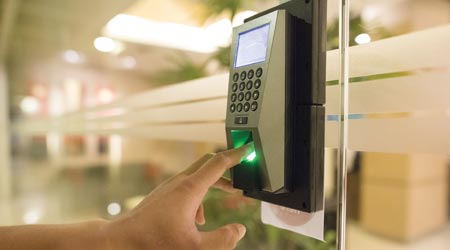Effective control and monitoring of door locks serve a fundamental role in any organization’s safety and security plan. The toughest challenge for maintenance and engineering managers is avoiding common problems when upgrading security and access control systems in an effort to improve the protection of occupants and assets from inside and outside threats, according to an article on the Facility Maintenance Decisions on the FacilitiesNet website.
Before beginning a security and access control upgrade, managers need to meet with key stakeholders in the process to establish well-defined goals. User groups, key maintenance personnel, security, information technology, consulting engineers and management all need to be part of the discussion that addresses the costs, inconvenience, and potential changes in operational procedures.
Common goals for any upgrade should include an increase in functionality, features and flexibility. Beyond these goals, managers specifying products and planning upgrades should look for reductions in key areas, including:
Vulnerability. Reducing vulnerability means reducing exposure to the possibility of being successfully attacked. Upgrades should include the incorporation of smart access credentials to replace legacy proximity card credentials that can be replicated easily. This step usually necessitates the replacement of all card readers. If a facility has never installed access control technology, moving to such a system reduces the potential for unauthorized key duplication while allowing managers to identify people used a particular door and at what times.
Operational costs. Battery-operated, wireless locksets with integral card readers reduce initial installation costs, but batteries require replacement, resulting in ongoing material and labor costs. Wireless locksets generally introduce additional complexity and points of potential failure.
Training needs. Intuitive graphical user interfaces with alarm handling automation can greatly reduce training for most users. Ask manufacturers for software demonstrations, and allow staff access to those demonstration stations. Give them a task to complete with no training and see how long it takes to complete the task. The benefits of intuitive interfaces will be apparent. Identify how many of your operational, maintenance, and IT staff will require training and include this in the project’s soft costs.

 Hand, Foot and Mouth Disease on the Rise
Hand, Foot and Mouth Disease on the Rise BayCare Reveals Pagidipati Children's Hospital at St. Joseph's
BayCare Reveals Pagidipati Children's Hospital at St. Joseph's Preparing for the Hazards of Winter Weather
Preparing for the Hazards of Winter Weather Why Identity Governance Is Becoming a Facilities Management Issue
Why Identity Governance Is Becoming a Facilities Management Issue Habitat Health Opens South Los Angeles PACE Center
Habitat Health Opens South Los Angeles PACE Center